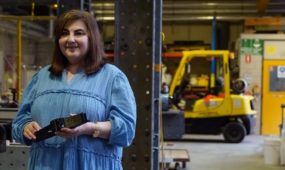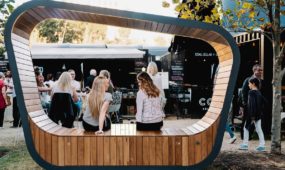Embracing change ensures Free Run Press beats downward media trend
Innovation
OWNING a media company is hard enough, but throw in a financial crisis and a general downturn in the industry and it becomes downright scary. South Australian publisher Cindie Smart has weathered the storm by embracing change and tailored business plans.

Sign up to receive notifications about new stories in this category.
Thank you for subscribing to story notifications.
That fact might not be obvious talking to founder Cindie Smart, though. She sits casually in the business’ suburban office surrounded by magazine history: past issues, awards, framed covers. Cindie easily talks her way through the company’s ten years.
Coming from a farming family, she wasn't born to a business background. It’s clear though — as she shrugs off the bad times and proudly describes their shrewd decisions and successes — that the business has taught her a lot along the way.
The business began in 2004 as WBM – Australia's Wine Business Magazine – when founders Cindie, Anthony Madigan and Peter Fuller were working for the company Winetitles.
They saw a gap in the market and decided to step in and fill it.
“We kept talking about how in the wine industry there were very technical magazines for grape growers and wine makers and then very consumer oriented magazines for wine drinkers — but nothing in the middle,” Cindie says.
“We kept saying what we need is a BRW (Business Review Weekly) for wine.”
Aspire and Parade are two of Free Run's latest magazines.
So instead of BRW they made WBM, or Wine Business Magazine.
“The feedback was amazing, the industry loved it,” Cindie “Then, of course, the wine industry glut happened. Business was tough.”
As their advertisers began to flounder and drop out, the group was forced to diversify.
“We started talking about a Barossa magazine – the idea for Barossa Living came about and we launched that in 2006.”
It’s here that a trend starts to emerge. Free Run Press has a stable of six magazines and nearly all of them focus on a specific niche — each geographically anchored to South Australia.
Adelaide Hills Magazine came about after Barossa Living. Then followed SAKids, for parents in South Australia.
“They’re all very targeted,” she says. “I think that’s the only reason they work. If they were more generic we wouldn't have a business.
“The beautiful thing to this point is that every time we did release a magazine, the feedback was great. It gave us the confidence and the financial momentum to keep going.”
Unfortunately for Cindie and Free Run, it wasn't going to be that easy. The GFC landed on their doorstep soon after SAKids launched.
“That was great,” Cindie laughs, though it’s clear there are bad memories tucked behind her humour.
Free Run spends a lot of time getting their design right – and they aren't afraid to do something different, like their well-known 'milk bath' cover above.
“It was a horrible time for anyone in business,” she says of the turmoil now. “Especially small business because you don’t have the mountains of cash to get you through the hard times.
“We’ve all got horror stories about the GFC and the desperate things that we did to get through that.
“My husband has no idea about this actually. But at one point I applied for a credit card to pay wages. We’d exhausted all the money the bank would give us. So that’s another 20 grand debt there, and the next fortnight you’d be thinking what else can we do?”
All they could do was hold on – and hope that in the interim the magazines would bring in money, the sales staff would do their job well, the advertisers would be prompt paying their invoices, or a cheque from the newsagencies would arrive.
“We got through it. Overall it’s probably been a really good thing for us. We’ve learnt to be really resilient. And not to worry about the little things,” Cindie says.
Free Run didn't take the time to rest or recuperate though. As soon as they could manage, their next custom magazine, Parade, was out the door. Aspire, a youth-centered, South Australia-wide magazine was next.
It’s this constant but measured expansion and diversification that marks their success and now, after the hardest times, their stability.
Their diversity lies not just in the topics their magazines cover, but also in their varied distribution methods and the separate arms of the business.
Almost all of their magazines run on different models, and Free Run has become more responsive to readers and the industry as a necessity in the current publishing environment.
WBM runs on subscriptions and has a reader base in roughly 50 countries around the world. Cindie says that it’s their baby – they probably pour more love in to WBM than anything else, but she acknowledges that the online bonus content, such as their ‘very wrong but very funny’ newsletter, The Week That Was, has a lot to do with its popularity.
Adelaide Hills Magazine is a traditional news agency based magazine – “it sells amazingly well,” Cindie says. Barossa Living started life the same way, but never reached the same level of success with that model.
Free Run finds success in its diverse portfolio of niche magazines.
“These days if people are selling half of the mags they send out, they think they’re doing amazingly well. If you send 10,000 copies to a newsagency and you sell 5,000, you’re happy.”
“But that means 5,000 are ending up in the recycling, that’s heartbreaking. It also means you have half as many readers. That’s exactly what was happening with Barossa Living.”
Free Run saw a solution if they were prepared to make a bold move – rather than 5,000 readers, what if they had 35,000? They began to distribute Barossa Living for free.
“Our publishing partners and contacts got in touch with us and asked, ‘what are you doing? You’re wrecking the industry!’ and we said, ‘no, no, we’re just trying to run a profitable business.”
And it worked – they were understandably nervous for a while, but the gamble paid off and advertisers started to flock back to the magazine.
“You hear it a lot. Newspapers are dying. Magazines are next. We say, okay, we’ll send you the stats – you’ll be surprised.”
Partnerships have also been key to their success. When some of the original founders stepped out of the business – Peter and Kathryn Fuller – Free Run brought new shareholders in to the fold.
A good with relationship with printing partner Newstyle ensures that Barossa Living is sustainable, even at the higher print run.
Aspire took up the same model and now, on its second issue, seems to be doing well.
“Print more, get it out to readers and don’t put any barriers between them and the magazine and see what happens. See if that helps the advertisers get a better response. And it’s working.”
For SAKids, a partnership with the Education Department means that it can land in the hands of just about any parent in the state.
“We just try things and watch it for a while. Make sure it’s working and then go okay – we’ll do that again!
“That’s the good thing now about having a good spread of different magazines. We have the ability to do some more trial and error.”
Free Run also dabbles in marketing, photography and printing magazines for local businesses, a further diversification of their portfolio.
“The future is really exciting. The great feedback and the financial position the magazines are in – plus the digital platforms. It’s definitely less stressful and more fun,” Cindie says.
Free Run Press’ digital strategy is quite vast; three magazines have complete tablet editions available on the Apple and Google Play stores, one is accompanied by an augmented reality app. The last two are set to follow shortly.
“We have to make sure we are doing everything we can to excite readers.”
Readers download the free Netpage app and point their phone at the pages of their magazine. It will play videos, link to online stores where they can buy the wine or clothes featured in an article, or take them to an advertiser’s page.
Their efforts at reader engagement over social media are significant too; most of their magazines boast thousands of online followers. It’s another way the business remains responsive to its readership.
“The numbers are huge for a magazine. Especially a niche magazine,” she says.
Gone are the days when a magazine is released and that’s it – it’s on the street and the writers return to their office.
“The editors are absolutely exposed and available,” says Cindie. “That’s the way it should be. The readers love it.
“When we ask people what they think about things and give them interesting content that’s shareable or they can comment on, that’s where we find engagement starts to work.”
Content promotion on its own isn't enough, Cindie says. Readers start to look through it – they’re just trying to flog us magazines! she shouts.
Overtime, Cindie predicts that the revenue provided from the digital editions and their related content will equalize with their print numbers.
“We are all working a lot harder than we ever have before for basically the same result, she says of the publishing industry. “That’s just the way it is, in every industry really.
“I used to think, ‘one day it will be like the good old days before the GFC and we’ll all have heaps of money again’ but I don’t think that will happen. It’s a different world now, and we’ve all learnt to work harder and smarter.”
“There’s that feeling in the air that innovation is a good thing… development is happening and people are embracing it. That’s opening business opportunities for anyone, really.”
“We have these things, ideas days. We go off to a bar – it sounds like we just drink all the time,” Cindie laughs, “it’s not that bad. We go and brainstorm for the whole day.”
“We look at each publication and platform and the business and we throw ideas out there. Some of them are mental.”
But they’ve also led to some amazing ideas that drive the business forward – and the ideas aren’t always from likely places.
“Our finance manager might come up with the most amazing story or advertising campaign.”
“It’s not always the people you would suspect be good at something that actually make your business more profitable.”
“We do that brainstorming whenever we can. We swallow our pride a lot.”
“We always ask our customers what we could do better.”
“It’s nice to have the background now to be a bit more secure and stable. It got really tight. There were times when we’d all get together and felt like pouring a glass of wine and saying, okay, let’s shut the doors and never come back.”
“As bad as it was at the time I’m glad we had some really hard times and big hurdles to jump because I don’t think I’ll make silly decisions. I think it’s good for businesses.”
“At the end of this year we’ll turn ten which is hard to believe. It does feel like just last year we started WBM.”
Going to throw a party?
“We’ll have to!”
The Wine Business Magazine app is available on iTunes for free.
The Barossa Living Magazine app is available on iTunes for free.
Jump to next article



